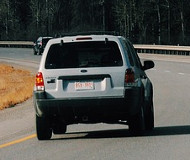Article from: www.thenewspaper.com/news/52/5201.asp
5/5/2017
New Mexico Court: Brushing The Edge Of A Lane Is Not Illegal
New Mexico Court of Appeals bans favorite police technique of stopping motorists for touching the yellow line at the edge of the road.
 Briefly touching the the painted yellow lines on a road while passing slow-moving traffic is not a crime that justifies a traffic stop, the New Mexico Court of Appeals ruled last week. A three-judge panel came to that conclusion after finding the March 20, 2013 traffic stop of Karen Siqueiros-Valenzuela was unjustified.
Briefly touching the the painted yellow lines on a road while passing slow-moving traffic is not a crime that justifies a traffic stop, the New Mexico Court of Appeals ruled last week. A three-judge panel came to that conclusion after finding the March 20, 2013 traffic stop of Karen Siqueiros-Valenzuela was unjustified.
New Mexico State Police Officer Joseph Garcia was looking to issue tickets on Interstate 40 near Grants when he saw Siqueiros-Valenzuela's vehicle signal, safely move into the fast lane to get around a pair of slow big-rig trucks, then move back to the right. In the process, her car's left-side tires briefly touched -- without crossing -- the yellow line marking on the edge of the passing lane. She did not come close to any other vehicle or obstruction, as opposing traffic on the interstate was separated by a wide median.
Officer Garcia said he "regularly" stops people for touching the line once, and this was no exception. He issued Siqueiros-Valenzuela a ticket for failure to maintain her lane. As with most traffic stop cases that reach the appellate level, this one quickly turned into a drug search. The three-judge appellate panel, however, only considered the case up to the point of the initial traffic stop based on the definition for lane changes used by most states.
"A vehicle shall be driven as nearly as practicable entirely within a single lane and shall not be moved from such lane until the driver has first ascertained that such movement can be made with safety," the New Mexico code states.
State prosecutors insisted that police should be able to cite this law to stop and ticket motorists for a single touch of a lane's boundary marker because it could be a sign of intoxication. The appellate court noted that a case involving the meaning of "as nearly as practicable" had never made it to this level in the court system. So the judges offered their binding interpretation.
"Expressing the phrase in its ordinary terms, the statute requires a driver to maintain his or her vehicle in a single lane -- as closely as feasible -- by utilizing good judgment and taking into account the safety considerations of a particular situation," Judge Timothy L. Garcia wrote for the court. "The very nature of this feasibility and safety qualification appears to indicate a legislative intent to avoid penalizing brief, momentary, and minor deviations outside the marked lines."
The judges looked to rulings in other states to find a consensus that touching the line, without crossing it, could never be a crime. Contrary to the assertions of prosecutors, the court found that Siqueiros-Valenzuela was driving more safely, not less safely, by touching the line.
"The district court could reasonably infer that defendant did in fact ascertain the safety of her movement by driving to the far left side of her lane while passing the semi-trucks -- it provided a safer distance than driving in the middle of her lane during this passing maneuver," Judge Garcia concluded.
With that, the court upheld the lower court's decision to toss the evidence against Siqueiros-Valenzuela. A copy of the ruling is available in a 120k PDF file at the source link below.
Source: New Mexico v. Siqueiros-Valenzuela (Court of Appeals, State of New Mexico, 4/25/2017)
Permanent Link for this item
Return to Front Page
 Briefly touching the the painted yellow lines on a road while passing slow-moving traffic is not a crime that justifies a traffic stop, the New Mexico Court of Appeals ruled last week. A three-judge panel came to that conclusion after finding the March 20, 2013 traffic stop of Karen Siqueiros-Valenzuela was unjustified.
Briefly touching the the painted yellow lines on a road while passing slow-moving traffic is not a crime that justifies a traffic stop, the New Mexico Court of Appeals ruled last week. A three-judge panel came to that conclusion after finding the March 20, 2013 traffic stop of Karen Siqueiros-Valenzuela was unjustified.